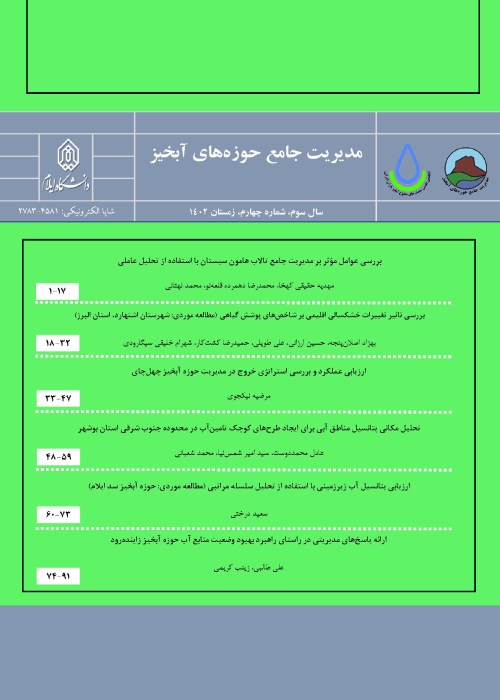The use of rainwater in sloping lands for the cultivation of Damask rose
Water limitation is regarded as one of the most important obstacles to agricultural development in arid and semi-arid climate regions. Rainwater harvesting is one of the most significant management methods of rainwater exploitation to deal with water shortage. Due to the wide variety of rainwater extraction methods, in choosing the appropriate method, special attention should be paid to features such as land topography, climate, soil type and socio-economic factors and the amount of water consumption to apply extraction methods in each region. In this research, the promotion of water catchment surface systems in the establishment and development of marigold cultivation in rainfed conditions has been discussed. The use of effective strategies to increase productivity in agriculture has been the focus of researchers for a long time. Any process that leads to the optimal use of rainwater and makes it possible to use it better is known as rainwater harvesting. The aim of this research is to promote the systems of water catchment surfaces in the establishment and development of rose cultivation in rainy conditions.
The research area was chosen on the northern slope of the village with a slope of about 20%. Soil depth was measured by sampling. An 80 cm deep nationwide channel was dug downstream of the systems with an excavator. The channel was filled with a mixture of straw and stubble and a combination of animal manure with soil (in the amount of 20% by volume) in order to increase the moisture retention capacity in the soil. To carry out the present research, 12 rectangular catchment systems with dimensions of 6 x 5 meters were built using earth mounds on slopes with a 20% slope. These systems, due to being located on the slope and carrying out a series of measures in their beds, cause the production and direction of runoff towards the target point (seedling cultivation site). Downstream of each system, a hole was considered for planting seedlings. The research was carried out in the form of three system treatments including: cleaned ground using a pebble filter in the seedling hole, semi-insulated system treatment using a pebble filter in the seedling hole and a control (natural ground cover) according to local custom. To make a semi-insulated system, the vegetation on the surface of the system was first removed and the system bed was insulated using thick nylon and a 3 cm layer of gravel on it. Also, the downstream part of the system at the seedling pit was paved using the rubble in the area to reduce evaporation. Gravel filters are a column of gravel that is built in the upstream part of the seedling using two polyca pipes with a diameter of 10 cm and a depth of 40 to 50 cm during embankment at the foot of the seedling. Gravel was poured inside the pipes. In order to establish a hydraulic connection between the gravel column and the soil of the pit and its surroundings, the lower part of the pipe was meshed. These filters are used to optimally penetrate the extracted runoff to the depth of tree root development. To build the bare system, vegetation and pebbles were collected from the surface of the system.
In variance analysis, the effect of irrigation treatments on the height trait in 2017 with a probability level of one percent (P<0.01) and in 2018 and 2019 the effect of treatment on the height trait at the probability level (P<0.05) was significant. The highest length of the height belongs to the third treatment (with filter and semi-insulating system) and the lowest height and crown belongs to the control treatment. Regarding the effect of the treatments on the crown length trait, it is significant in all years 2017, 2018, 2019, 2020 and 2021. In 2019, it is significant at the level of one percent (P < 0.01) and in the years 2017, 2018, 2014 and 2011 at the probability level (P < 0.05). In the years 1400 and 1401, the effect of the treatments on the height trait is not significant. The results show that the effect of the treatments on the crown is greater than that on the height. The highest crown was obtained in the third treatment (with filter and semi-insulated system) and the lowest crown was obtained in the control treatment. According to figure (5), in the years 2017, 2018 and 2019, the total rainfall in the spring season was 247, 285 and 187 mm, respectively, and in the years 1400 and 1401, it was 31 and 14.5 mm, respectively. Rainfall has a direct effect on the treatments. In fact, the amount of rainfall and its management in terms of systems of catchment surfaces, filters and insulation have a direct effect on the amount of moisture at the base of the plant, the water required by the plant, and the vitality of the rose.
The results showed that in the analysis of variance, the effect of irrigation treatments on the height trait in 2017 was significant with a probability level of one percent (P<0.01) and in 2018 and 2019, the effect of the treatment on the height trait was significant at the probability level (P<0.05). The highest length of the height belongs to the third treatment (with filter and semi-insulating system) and the lowest height and crown belongs to the control treatment. Regarding the effect of treatments on crown length in all years 2017, 2018, 2019, 2020 and 2021, it is significant. In 2019, it is significant at the level of one percent (P < 0.01) and in the years 2017, 2018, 2014 and 2011 at the probability level (P < 0.05). In the years 1400 and 1401, the effect of the treatments on the height trait is not significant. due to the the effect of spring rainfall on filter treatments and semi-insulated and filter systems.
- حق عضویت دریافتی صرف حمایت از نشریات عضو و نگهداری، تکمیل و توسعه مگیران میشود.
- پرداخت حق اشتراک و دانلود مقالات اجازه بازنشر آن در سایر رسانههای چاپی و دیجیتال را به کاربر نمیدهد.



